Whether you’re a beginner aquarist or a seasoned pro, one question you may have is “Can snails and betta fish live together?” The answer is yes, but there are a few things you need to take into account before adding these different species to your aquarium.
This article will give you an overview of what you need to know about keeping snails and betta fish together. We’ll discuss their compatibility, the best way to set up your aquarium, and what to watch out for. With a little bit of planning and preparation, you can reap the benefits of having both of these animals in your tank!
Why Would You Want To Put Snails and Bettas Together?
There are a few reasons why you might want to keep snails and bettas together in your aquarium.
For one, snails can help keep your tank clean. They eat algae and other detritus, which helps to keep the water quality high. This is especially beneficial if you have a betta, as they are particularly sensitive to poor water quality.
Another reason to keep these animals together is that they can provide companionship for each other. Bettas are social creatures and do their best when they have tankmates to interact with. Snails can help to fulfill this need, as they are often active during the day when bettas are awake and swimming around.
Lastly, having both snails and bettas in your aquarium can add some visual interest. Bettas are brightly colored and have long, flowing fins, while snails come in a variety of colors and patterns. Adding both of these animals to your tank can create a lively and beautiful display!
Compatibility
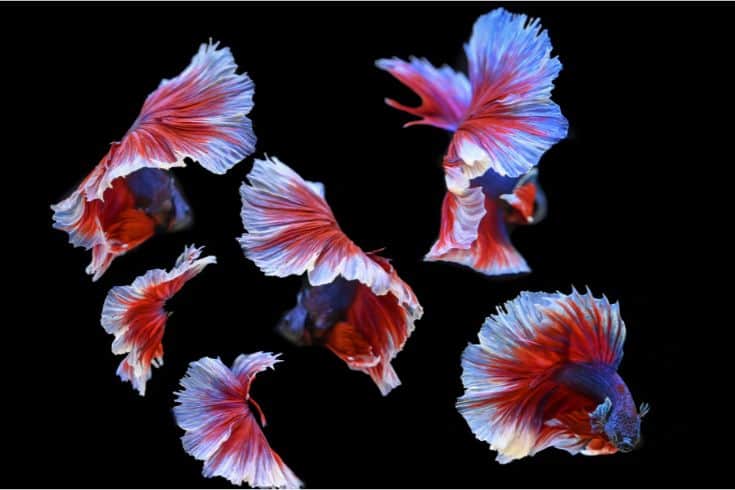
Now that we’ve looked at some of the reasons why you might want to keep snails and bettas together, let’s discuss their compatibility. Generally speaking, snails and bettas get along well together. However, there are a few things you need to take into account before adding them to your tank.
Make Sure Your Bettas Don’t Eat The Snails
It’s not common for bettas to eat snails, but it can happen.
If your betta is particularly hungry, it may go after a snail. That said, there are a few things you can do to discourage your betta from eating snails:
- Make sure you’re feeding your betta a high-quality diet. A healthy betta is less likely to be interested in eating snails.
- Provide plenty of hiding places for your snails. If they have places to hide, they’re less likely to be eaten by a betta.
- Monitor your bettas for signs of stress. A stressed betta is more likely to eat snails (or other tankmates). If you’re concerned about your betta-eating snails, it’s best to err on the side of caution and not put them in the same tank.
Choose The Right Size Snail
Not all snails are created equal! There are many types of snails, and they come in various sizes. Choosing the right size snail is important if you want to keep them with bettas. Generally speaking, it’s best to opt for midsized snails that wouldn’t be able to fit into a betta’s mouth.
Consider The Tank Size
When keeping any type of pet, it’s important to consider the size of their enclosure. This is especially true when keeping multiple animals together. Snails and bettas can live in the same tank, but you need to make sure the tank is large enough to accommodate both species.
A good rule of thumb is to choose a tank that is at least 10 gallons in size. This will give your snails and bettas enough room to move around and stay healthy.
Be sure to also consider the size of your snails when choosing a tank. Larger snails like the Japanese Trapdoor Snail will need a larger tank to accommodate their size.
Provide Plenty Of Hiding Places
Snails are not the most active animals in the world. They spend a lot of their time hiding away in shells or under rocks. This is one reason why they make such good tank mates for bettas.
To keep your snails safe from predation, it’s important to provide plenty of hiding places in the tank. This can be anything from rocks to driftwood to aquarium plants. As long as there are plenty of places for your snails to hide, they should be safe from curious bettas.
Hiding spaces are also incredibly important to bettas, as they help to reduce stress levels. So, by providing hiding places for your snails, you’re also helping to keep your bettas healthy and happy.
Setting Up Your Aquarium Tank With Snails
Now that you know a little bit more about keeping snails and betta fish together, let’s talk about setting up your aquarium.
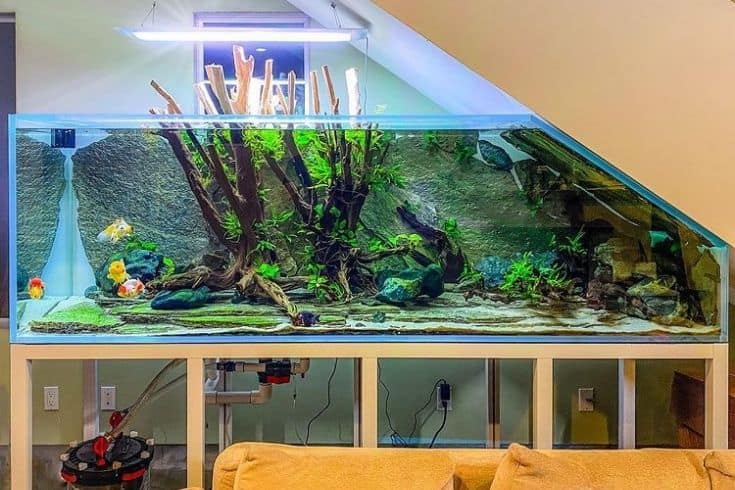
Step 1: Gather Your Supplies
The first step in setting up a tank with bettas and snails is gathering all the supplies you’ll need. This includes:
- Aquarium
- Aquarium filter
- Aquarium heater
- Gravel
- Live plants
- Decorations
- Betta fish
- Snails
Step 2: Choose The Right Location for Your Aquarium
When setting up any type of aquarium, it’s important to choose the right location. The tank should be placed in a room that is away from direct sunlight and drafts. The room’s temperature should also be stable, as fluctuations can stress fish and make them more susceptible to disease.
You should also look for a spot that is close to an outlet. Aeration is very important, so you’ll need to ensure the tank is close to an outlet so you can plug in the air pump. You can also add air stones to aerate the water, and introduce more plants to the tank to help with oxygenation.
Step 3: Add Gravel and Plants
Once you’ve chosen the perfect location for your aquarium, it’s time to start setting it up. The first step is to add gravel and live plants to the tank. Adding gravel to the bottom of the tank helps to create a natural look. It also provides a place for beneficial bacteria to live, which helps to keep the water clean.

After you’ve added the gravel, introduce your plants and decoration. You can cycle your tank with live plants, which will help to keep the water clean and provide oxygenation. Add enough plants so your snails and bettas will have plenty of hiding places. However, you should also leave enough space for the betta fish and snails to move around.
Step 4: Install the Filter and Heater
After the gravel and plants are in place, it’s time to install the filter and heater. These two items are essential for keeping your tank clean and comfortable for your fish and snails. Choosing a filter that is the right size for your tank is important.
You’ll also need to choose an aquarium heater that can maintain a stable water temperature in the tank. Bettas prefer water that is between 76 and 82 degrees Fahrenheit, so be sure to choose a heater that can maintain this temperature range.
When in doubt, always consult your local fish store or a professional aquarium technician to help you choose the right filter and heater for your tank. Most fish store owners are happy to point aquarium owners in the right direction when they need help!
Step 5: Add Your Bettas and Snails
Has your tank been completely cycled? Are your filter and heater working properly? If so, then it’s time to add your bettas and snails to the tank.
Start by acclimating your bettas to the water. Slowly add some tank water to their bowl or container to do this. This should be done over about an hour. After an hour has passed, you can release your bettas into the tank.
Next, it’s time to add your snails. You can acclimate them to the water in the same way you did with your bettas. But, since snails are much harder to catch, you may want to add them to the tank and let them adjust independently.
Step 6: Monitor Your Tank
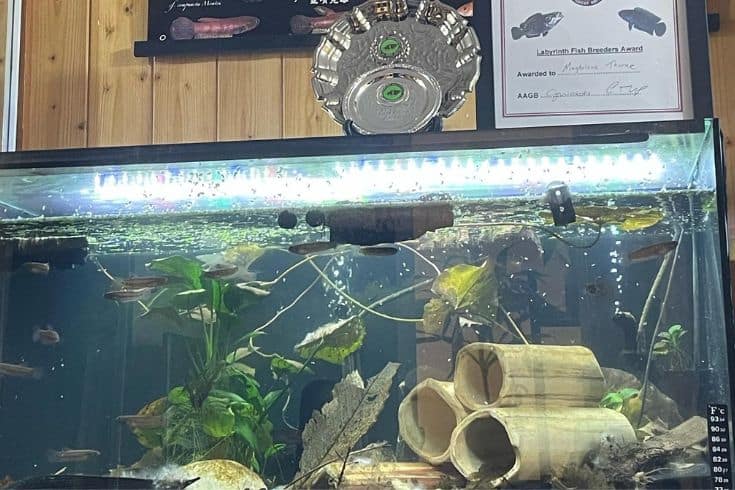
Now that your tank is set up and all of your fish and snails are in place, it’s time to sit back and enjoy your new aquarium. But, don’t forget to monitor your tank closely for the first few weeks.
Check the water quality regularly, and keep an eye on your fish and snails to make sure they are adjusting well to their new home. If you notice any problems, be sure to address them right away.
Creating A Balanced Ecosystem for Bettas and Snails
Now that you know how to set up a betta fish aquarium, you can enjoy the beauty and relaxation that comes with owning your own little piece of the underwater world. However, creating a balanced ecosystem in your tank is essential for the health and happiness of your fish and snails.
The difference between simply setting up a tank and creating a balanced ecosystem is that a balanced ecosystem is self-sustaining. That means the tank’s plants, fish, and other creatures work together to keep the water clean and the environment healthy. Here are a few ways you can create a balanced ecosystem for your pets:
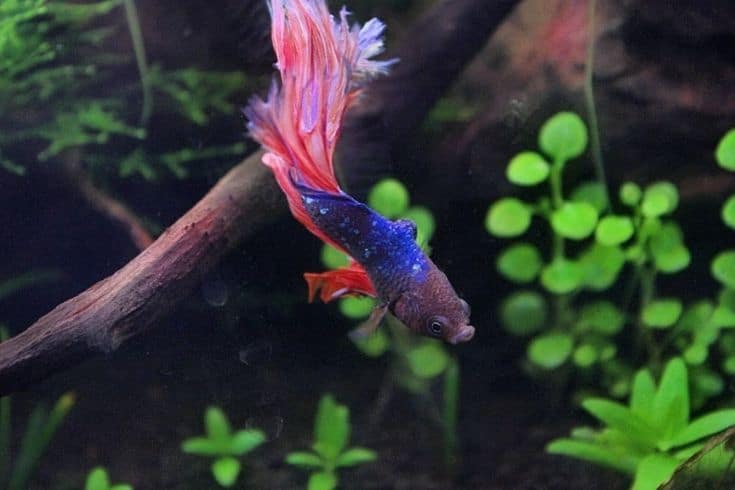
- Add plenty of aquatic plants. Plants help create a naturalistic environment and provide hiding places and food for your snails. Java moss and soft algae are good plants to add to a snail/betta aquarium. However, they require some extra care, as most snail types do.
- Use a quality filter. A good filter will help to keep the water in your aquarium clean and free of harmful toxins. This is important for the health of both your snails and bettas.
- Avoid using sand as a substrate. Sand can be harmful to snails, as it can get into their gills and cause respiratory problems. Gravel or bare-bottom tanks are best for snail/betta aquariums.
- Minimize the risks of ammonia spikes by getting rid of snails that have died, removing uneaten fish food, and monitoring water conditions regularly.
- A sudden increase in snails could be a sign of excess waste in your tank. Snails will happily gobble up all forms of algae, so make sure you keep your the growth of algae under control. Use a gravel vacuum to remove fish waste and food leftovers.
Once you’ve created a balanced ecosystem in your aquarium, you can sit back and enjoy watching your bettas and snails thrive. Creating a thriving underwater world is a fun and rewarding experience that will bring you years of enjoyment.
Feeding Snails In Betta Tanks
If you want your snails to thrive in your betta’s tank, you need to give them a proper diet.

What you should do:
- Provide them with algae. This can be done by adding algae tablets or wafers to the tank. You can also grow algae in a separate container and add it to the tank as needed.
- Give your snails with high-quality snail food. This food is specifically designed for snails and contains all the nutrients they need to stay healthy. Calcium-rich food can do wonders for their strength and overall health. You can find these food options at most pet stores or online.
- Supplement your snail’s diet with vegetables and fruits. Some good options include cucumbers, zucchini, and spinach. You can also offer them frozen or live foods, such as brine shrimp or bloodworms.
- Algae pellets can make excellent substitutes for the real deal if your algae control efforts are too successful. Otherwise, you may find your aquarium snails searching for leftover food on the bottom of the tank! You want to minimize interspecies altercations as much as possible.
By following these tips, you can ensure your snails get the nutrients they need to stay healthy and happy.
Snails That Get Along With Bettas
Knowing how to set up a safe and healthy environment for your bettas and snails is half the battle. The hardest part is finding snail species that will actually get along with your bettas! But don’t worry – we’ve done the legwork for you and compiled a list of the best snail species to keep with bettas. Here are some of our top recommendations!
1. Pond Snails
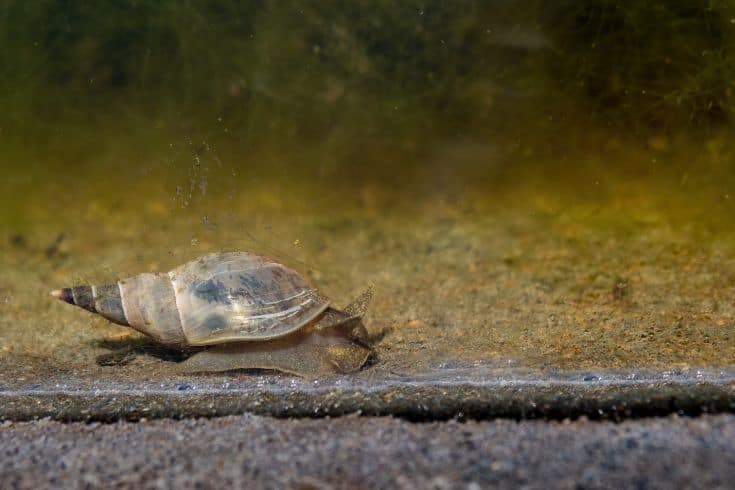
First on our list is one of our favorite snail species – the pond snail. Yes – we know that the humble Lymnaea stagnalis is often considered a pest, but hear us out! Pond snails are one of the best options for betta bowls and tanks because they’re small, peaceful, and easy to care for. They’re also great at keeping your tank clean, as they’ll happily munch on algae and other organic debris.
However, the downside of pond snails is that they’re prolific breeders. If you’re not careful, you could end up with hundreds of these little critters in no time! However, this can easily be avoided by keeping your snail population in check with regular water changes. Removing any eggs you see is also a good way to prevent a population explosion.
Pond snails are an excellent choice for beginner snail keepers and make great tank mates for bettas. If you’re looking for a low-maintenance snail species that’s easy to care for, pond snails are a great option.
2. Japanese Trapdoor Snails
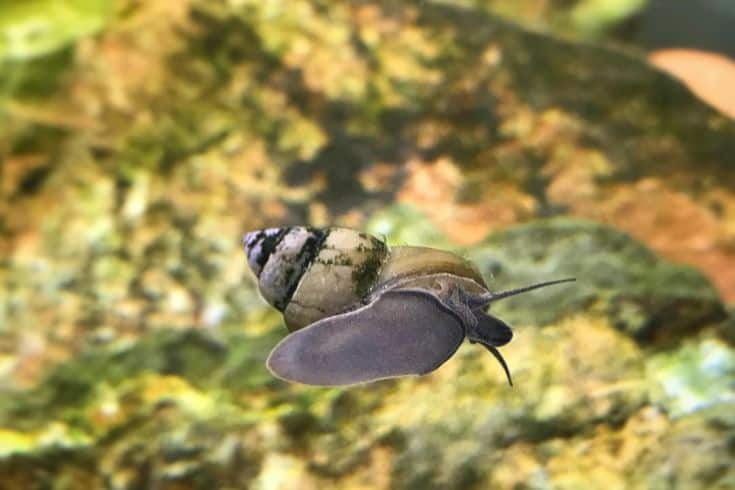
As one of the very few snails with a “trapdoor” or operculum at the opening of their shells, the Japanese Trapdoor Snail is yet another popular choice among aquarium owners. These easygoing little creatures aren’t just fantastic companions for Siamese fighting fish — they get along with virtually any fish species that can’t fit them into their mouths!
Appearance-wise, Japanese Trapdoor Snails are usually dark brown or black, with a glossy shell reaching up to 2 inches in length. Despite their nondescript appearance, these snails have an incredible superpower. Their operculum allows them to close themselves off entirely inside their shells, making them much less vulnerable to attack from predators.
Remarkable as these snails may be, it’s important to remember that they’re not the best option for beginner snail keepers. Japanese Trapdoor Snails require a bit more care than some of the other snail species on this list and are also more sensitive to water conditions. If you’re thinking of adding Japanese Trapdoor Snails to your aquarium, be sure to do your homework beforehand.
3. Rabbit Snails
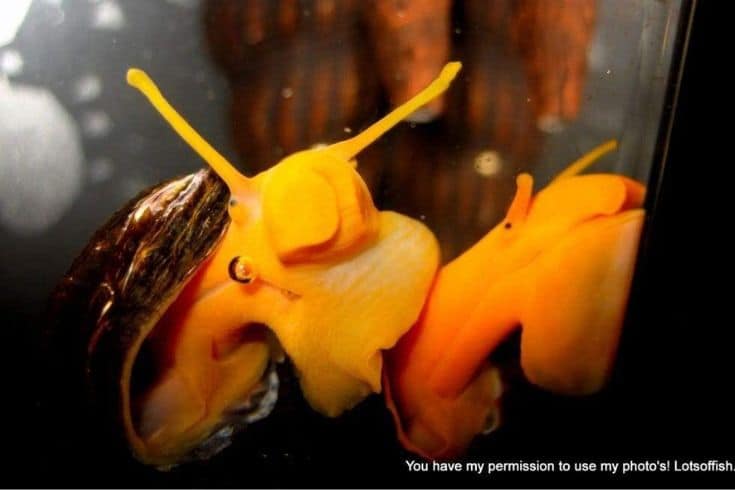
Much like the bunnies they’re named after, Rabbit Snails are a peaceful species and very easy to care for. These adorable little creatures make an ideal choice for bettas, as they’re not known to harass or bother other fish. Rabbit snails are content to spend their days grazing on algae, detritus, and leftover fish food — making them a great addition to any aquarium.
In addition to their easygoing personalities, rabbit snails have one of the most unique shell shapes in the snail world. Their long, dark, spiraling shells can grow up to 2.5 inches in length and are beautifully contrasted against their bodies’ bright orange or yellow. Next to the beautiful betta fish, a tank full of Rabbit Snails is sure to be a real show-stopper!
As with any omnivorous snail species, it’s essential to make sure your Rabbit Snails are getting a good mix of animal-based protein and plant-based fiber in their diet. A high-quality snail food pellet is a great way to ensure your pet snails are getting all the nutrients they need, though you can also opt for a combination of algae wafers and live protein sources.
4. Assassin Snails
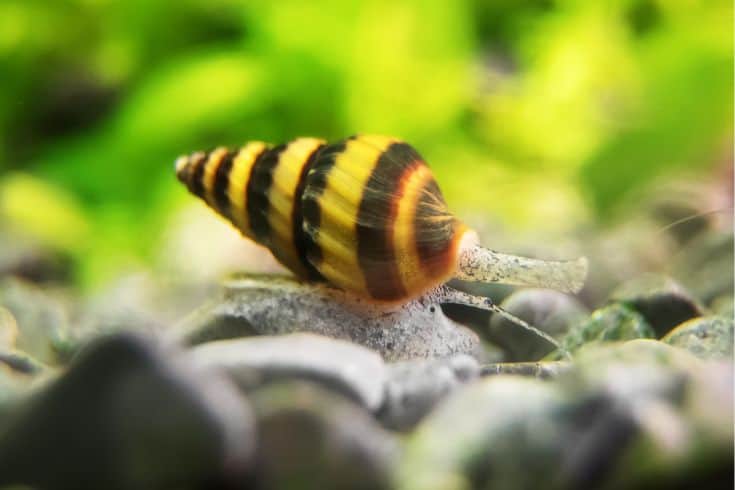
Cue the Mission Impossible soundtrack! As their name suggests, Assassin Snails are constantly hunting for something yummy to eat. These carnivorous aquarium snails are known for hiding in the substrate, waiting to ambush unsuspecting prey. While this might not sound like the best trait for a snail species that are going to be living with bettas, don’t worry — Assassin Snails are not known to attack or eat fish.
Instead, these voracious little creatures prefer to feast on other species of snails and invertebrates. This makes them perfect for Betta fish owners dealing with snail infestations. Adding Assassin Snails to their tank can help keep the population of harmful or nuisance snails in check, without harming your betta fish. What a win-win situation for both the fish and the snail!
One word of caution, however: because Assassin Snails are such voracious eaters, it’s important not to overfeed them. A few extra snails here and there is no problem, but if you find that your Assassin Snails are starting to decimate the snail population in your tank, it might be time to rehome them. Place them in a tank with no potential prey, or gift them to another aquarium owner dealing with a snail problem.
5. Mystery Snails
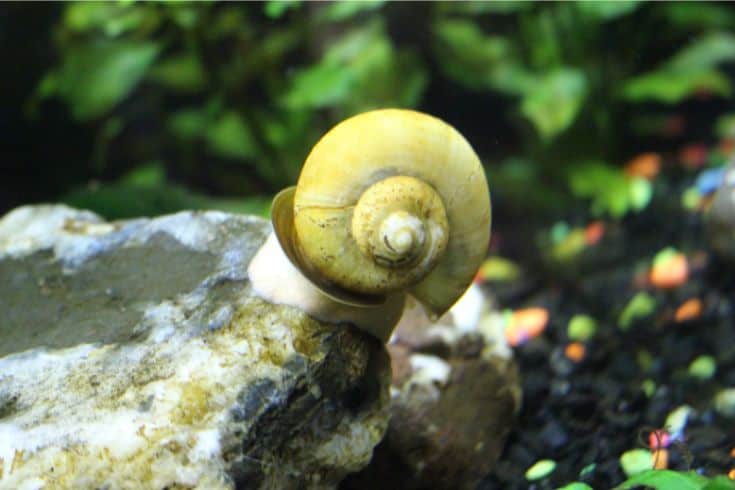
Mystery snails are named as such because of their unique breeding habits. The female snails will lay their eggs right above the water’s surface, allowing them to go undetected. The “mystery” comes into play when the baby snails hatch and fall into the water. For a long time, no one could figure out how these fully formed baby snails appeared in their tanks!
Adorable breeding habits and backstory aside, these active nails make remarkable tank mates for bettas. They grow to a generous 2 inches in diameter and will busy themselves with grazing all day long. The fact that they are one of the largest freshwater snails in the hobby means that they will likely get along well with most fish species – even those that might view smaller snails as a tasty snack.
Because mystery snails are herbivores, they can also be kept with other snails and invertebrates that share their diet. They won’t feast on their tank mates like the Assassin Snails, but they will compete with them for food. Be sure to provide plenty of algae wafers and other plant-based snacks to keep everyone in the tank happy and healthy.
6. Turret Snails
Did the turret snail’s name make you think of a cute little castle? Sorry to disappoint, but these snails get their name from the cone-shaped shells that protect their bodies. The turret snail is a small species, only growing to be about an inch in length. Their willingness to eat almost anything makes them excellent snail species for a betta tank – these make a highly reliable cleanup crew.
Janitorial tendencies aside, turret snails are also known for their inquisitive nature. They’re constantly exploring their tanks, and can often be found perched on plants or rocks. This active behavior means they make interesting tank mates for bettas, who also enjoy exploring their homes. They may not necessarily interact, but they’ll certainly keep each other entertained.
Turret snails have simple needs, but clean water is an absolute must. These snails are very sensitive to ammonia and nitrite levels, so test and change your water frequently. Additionally, provide plenty of hiding spots and a soft substrate for these snails to burrow into. A betta tank with lots of live plants is ideal, but a few pieces of driftwood or smooth rocks will also suffice.
7. Malaysian Trumpet Snails

The red-rimmed melania is colloquially known as the Malaysian trumpet snail. Like bettas, these little guys originate from Southeast Asia. Their love of warm water makes them ideal tank mates for bettas. They’ll do well in aquarium water between 75 and 82 degrees Fahrenheit, which is right in the sweet spot for most betta tanks. Invest in a reliable thermometer to keep everything ideal for these guys!
One of the most notable things about Malaysian trumpet snails is their scavenging habits. They are constantly looking for uneaten food and decaying plants, which they will consume with gusto. This makes them an excellent addition to a betta tank, as they help to keep the water clean and free of organic debris, algae, or other detritus.
In addition to their helpful scavenging habits, Malaysian trumpet snails are also perfectly sized and rather attractive. These snails have glossy shells that come in various colors and will grow to be about an inch in length. This makes them perfect tank mates for bettas, as they are too large to be eaten but not so large that they will overwhelm the tank.
8. Apple Snails
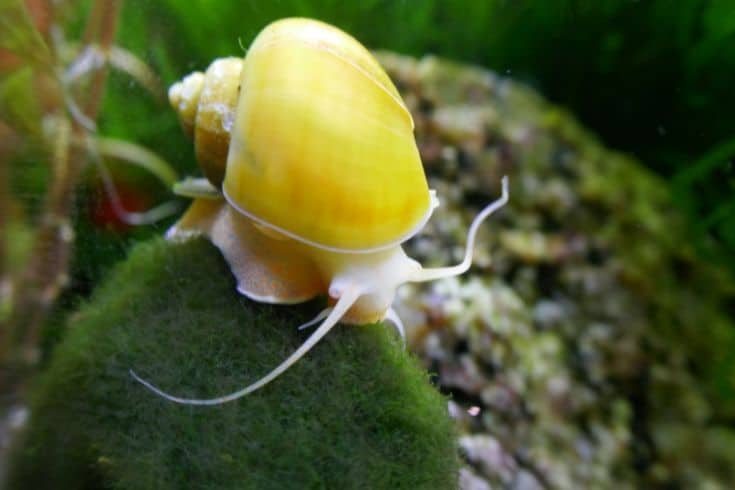
Last but not least, we have the apple snail. Of the many different snail types we have discussed, the apple snail is probably one of the most well-known. These snails are easily recognizable by their large size and striking coloration.
Because apple snails can grow up to 3 inches in length, they can be kept in a betta aquarium without worry. These peaceful creatures are large enough to escape predation, but will mostly keep to themselves. They are not known for being particularly active but can often be seen crawling around the tank or grazing on plants.
Apple snails are also effective algae eaters, and will help to keep your betta tank clean. Because of their large size, however, they will require additional feeding. Algae and detritus may not be enough to sustain them, so supplement their diet with blanched vegetables or commercial snail food.
Snails To Avoid
Based on the list above, you might assume that all snails are good tank mates for bettas. Unfortunately, this is not the case. Certain snail species simply do not do well with bettas, and should be avoided. For instance, some snails are too small, while others have multiplied so quickly that they’ve become a nuisance. Either way, here are four snail types to avoid when setting up a betta tank:
1. Pest Snails
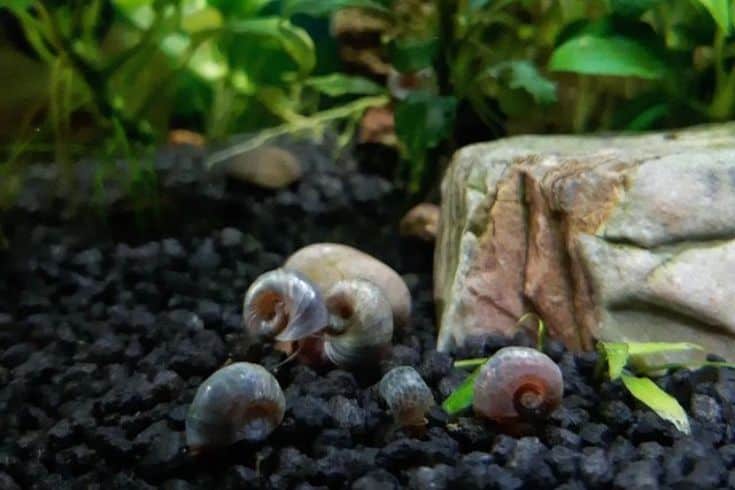
Too much of a good thing can quickly become a bad thing when it comes to snails. There isn’t a specific type of snail that is universally considered a pest – the term simply refers to snail populations that have gotten out of control. In other words, any snail introduced to your tank as part of an unplanned population explosion can be considered a pest.
Pest snails are often the result of overfeeding, and they can quickly become a nuisance. We recommend looking at your feeding habits if you’re dealing with a sudden snail increase. Is there a ton of algae in your tank? Do you have more uneaten food than usual? If so, that’s likely the culprit. Getting rid of snails will become easier once you’ve identified the root cause.
2. Tiny Snails
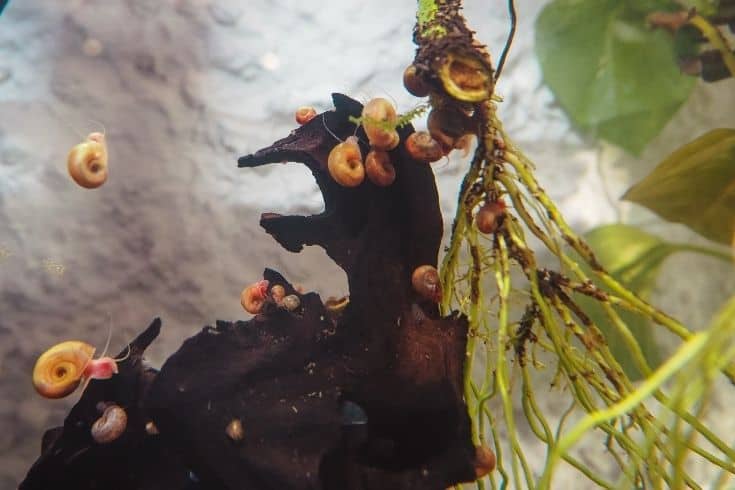
Next on our list is something many hobbyists fail to consider – snail size. Most people think of the average snail when considering potential tankmates for their bettas, but forget one vital fact – that these snails reproduce. Many newborn snails only measure a couple of millimeters in diameter, and should not be kept with betta fish. Otherwise, these pellet-sized snails might be mistaken for a tasty treat.
On the other hand, larger snails simply do not fit into the mouths of bettas. As a result, you don’t have to worry about your betta eating a giant snail – though more feisty individuals may still try. The good news is that the average snail will grow to an appropriate size relatively quickly. If you have a few snails that are too small, simply wait a few weeks, and they should grow to a more suitable size.
3. Nerite Snails
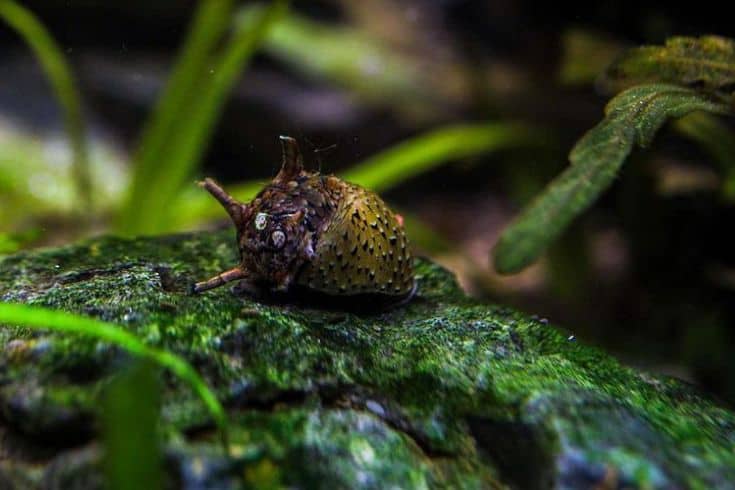
It may be surprising to see nerite snails on this list, as they are considered one of the best snail species for an aquarium with bettas. However, nerite snails prefer brackish water that is slightly alkaline, which is not ideal for bettas. As fish prefer neutral, slightly acidic water, bettas should not be kept with snails that prefer water parameters on a vastly different spectrum.
Some people may argue that both species can meet somewhere in the middle. This is a valid point. Both bettas and nerite snails are hardy creatures and will be able to adapt to water parameters that are a little less than perfect. However, we think this is unfair to the snail or the fish. Both animals will be much happier and healthier living in optimal water conditions – not just acceptable ones.
4. Red Ramshorn Snails
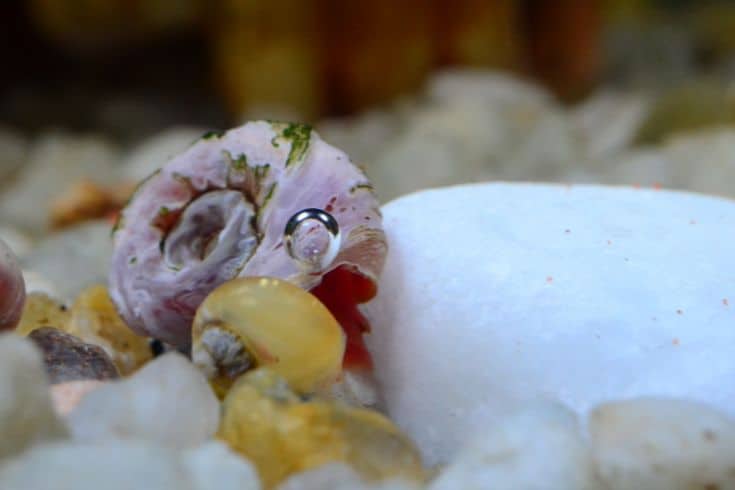
Last but not least, we have red ramshorn snails. While the beautiful color of their shells is certainly eye-catching, these snails should be avoided if you have a betta. That’s because bright colors are known to trigger aggression in bettas, and you don’t want your fish to become agitated for no reason.
In addition, ramshorn snails will reproduce almost as soon as they’re added to a tank. This is perfect for people looking to increase their snail population, but it’s certainly not ideal for those with bettas. A sudden influx of snails can throw your water parameters into disarray, and that’s the last thing you want.
FAQ
Do Snails Produce A Lot of Waste?
Yes, they produce a lot of waste, and their bio-load is just too high for smaller setups. You will need to do weekly water changes to keep the ammonia levels in check.
How Do You Tell If Your Snails Are Dead?
Your snail is probably dead if:
1. It is lying there completely motionless. If so, you should remove the snail from the tank. This can be done with a net to scoop the snail out of the tank or simply use your hand.
2: You catch a whiff of a pungent stench. Under these circumstances, you should clean the area where the snail was. This will help prevent the spread of disease. Testing the water will also give you an idea of whether or not you need to perform a water change (Hint: The answer is most likely yes!)
3. The insides of the shell are empty. Nine times out of ten, this happens because an opportunistic betta has consumed the insides of the dead snail. If this is the case, you should remove the snail from your tank, and dispose of it safely. Leaving an empty shell in your tank will wreak havoc on your water parameters, so make sure you dispose of your dead snail’s remnants!

Can Your Betta Fish Live With Snails? A Quick Recap
So, can your betta fish live with snails? Yes! But here are the major takeaways to remember:
- Your Betta might try and eat the slimy creatures if he is feeling sick or hungry (or just wants some seafood), so it may be best not place them in his tank without supervision
- Though snails may be good tank cleaners, they have a high bio-load, which means they can quickly pollute the water if too many are in the tank. It is important to do regular water changes (weekly or bi-weekly) to keep the ammonia levels in check.
- If you see a dead snail in your tank, remove it! Dead snails can spread disease, so it’s best to get rid of them as soon as possible. The best way to dispose of a snail is to bury it in your backyard.
The Takeaway
To summarise, snails are good betta tank mates. They are both peaceful creatures that can co-exist peacefully in the same aquarium. As long as you keep our pointers in mind, you’ll have no problem keeping your betta and snail friends happy and healthy!
We hope this guide has been helpful in teaching you about taking care of betta fishes and snails. Please feel free to share it with other betta enthusiasts or aquarium hobbyists!
Happy fish keeping!
